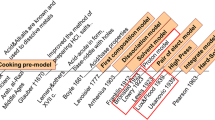Abstract
In this work, we propose to identify the knowledge that Tunisian grade 10 students build up concerning acids and bases. Thus, after learning, we have proceeded by giving a paper and pencil task to students of two levels of teaching. The results obtained allow us to say that the assimilated knowledge is transitory; that the students have a worse perception of the base than of the acid concept and these two concepts are independent; that they associate the acid or base strength to its concentration; that the pH is far from being a “tool” of estimation of the degree of acidity; and that the students have difficulty in linking the empirical and the models’ registers. Moreover, some alternative conceptions that can be harmful to the learning of Brønsted’s model appear.
Similar content being viewed by others
References
Besson, M.A. (1994). Approach of the notions of acid and base by the students at the end of the secondary. In Proceedings of the fourth national seminary of the research in didactics of the physical sciences, Amiens, France, (pp. 93–100), “Institut Universitaire de Formation des Maîtres” of Picardy.
Botton, C. (1995). Collaborative concept mapping and formative assessment key stage 3: Understanding of acids and bases. School Science Review, 77(279), 124–130.
Camacho, M. & Good, R. (1989). Problem solving and chemical equilibrium: Successful versus unsuccessful performance. Journal of Research in Science Teaching, 26(3), 251–272.
Cisse, Z. (1998). School knowledge and professional skills: The case of acids and bases in agriculture. Diploma of Detailed Studies of didactics of the scientific disciplines, Claude Bernard Lyon 1 University (France).
Cros, D., Maurin, M., Amouroux, R., Chastrette, M. & Fayol, M. (1986). Conceptions of first-year university students of the constituents of matter and the notions of acids and bases. European Journal of Science Education, 8(3), 305–313.
Davy, H. (1810). Research on the oxymuriatic acid, its nature and combination, and on the elements of the muriatic acid, with some experiments on sulphur and phosphorous. Philosophical Transactions of the Royal Society, 231–257
De Vos, W. & Pilot, A. (2001). Acids and bases in layer: The stratal structure of an ancient topic. Journal of Chemical Education, 78(4), 494–499.
Dori, Y. & Hameiri, M. (2003). Multidimensional analysis system for quantitative chemistry problem: Symbol, macro, micro and process aspects. Journal of Research in Science Teaching, 40(3), 278–302.
Driver, R., Squire, A., Rushworth, P. & Wood-Robinson, V. (1994). Making sense of secondary science. London: Routledge.
Garnett, P.J., Garnett, P.J. & Hackling, M.W. (1995) Students’ alternative conceptions in chemistry: A review of research and implications for teaching and learning. Studies in Science Education, 25, 69–95.
Hand, M.B. (1989). Student understandings of acids and bases: A two-year study. Research in Science Education, 19, 133–144.
Hand, M.B. & Treagust, D.F. (1988). Application of a conceptual conflict teaching strategy to enhance student learning of acids and bases. Research in Science Education, 18, 53–63.
Harrison, A.G. & Treagust, D.F. (2000). Learning about atoms, molecules, and chemical bonds: A case study of multiple-model use in grade 11 chemistry. Science Education, 84, 352–381.
Hawkes, S-J. (1992). Arrhenius confuses students. Journal of Chemical Education, 69(7), 542–543.
Johnstone, A.H. (1980). Chemical education research: Facts, findings and consequences. Nyholm Lecture. Chemical Society Reviews, 9(3), 365–380.
Johnstone, A.H. (1991). Thinking about thinking. International Newsletter of Chemical Education, 36, 7–11.
Lavoisier, A.L. (1789). Traité élémentaire de chimie, Cuchet Libraire, Paris, reproduction de l’édition originale, Culture et Civilisation, Bruxelles, 1965, Libraire Blanchard, Paris.
Liebig, J. (1838). Lettre de Mr Liebig à Mr le Président. Comptes Rendus de l’Académie des Sciences, 6, 823–829.
Martinand, J.L. (1992). Education and learning of the modelling in sciences. Paris: Institut National de Recherche Pédagogique/LIREST.
Naklheh, M.B. (1994). Students’ models of matter in the context of acid-base chemistry. Journal of Chemical Education, 7(6), 495–499.
Nakhleh, M.B. & Krajcik, J.S. (1994). Influence of levels of information as presented by different technologies on students’ understanding of acid, base and pH concepts. Journal of Research in Science Teaching, 31(10), 1077–1096.
Ouertatani, L., Trabelsi-Ayadi, M., Dumon, A. & Soudani, M.L. (2005). Acids and bases: Between the common perception and the scientific models – the Tunisian pupils. In INRP (Ed.), Actes des Quatrièmes rencontres de l’ARDIST (pp. 273–276). France: Lyon.
Oversby, J. & Spear, M. (1997). Progression in understandings of pH at secondary school: A study of a whole school. In Proceeding of the 4th ECRICE Conference York, UK, (pp. 9–12).
Ross, B. & Munby, H. (1991). Concept mapping and misconceptions: A study of high-school students understanding of acids and bases. International Journal of Science Education, 13(1), 11–23.
Taber, K. (2001). Building the structural concepts of chemistry: Some considerations from educational research. Chemistry Education: Research and Practice In Europe, 2(2), 123–158.
Toplis, R. (1998). Ideas about acids and alkalis. School Science Review, 80(291), 67–70.
Vinner, S. (1997). The pseudo-conceptual and the pseudo-analytical thought processes in mathematics learning. Educational Studies in Mathematics, 34, 97–129.
Zoller, U. (1990). Students’ misunderstandings and misconceptions in college freshman chemistry (general and organic). Journal of Research in Science Teaching, 27(10), 1053–1065.
Author information
Authors and Affiliations
Corresponding author
Rights and permissions
About this article
Cite this article
Ouertatani, L., Dumon, A., Trabelsi, M.A. et al. Acids and Bases: The Appropriation of The Arrhenius Model by Tunisian Grade 10 Students. Int J Sci Math Educ 5, 483–506 (2007). https://doi.org/10.1007/s10763-006-9049-4
Received:
Accepted:
Published:
Issue Date:
DOI: https://doi.org/10.1007/s10763-006-9049-4




